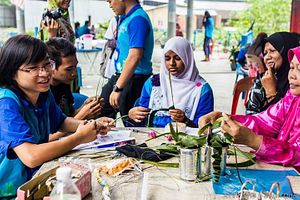On February 26, the Pew Research Center released a new report evaluating the latest global trends in religious restrictions and hostilities, which includes data for the year ending December 31, 2013. As was the case with a recent report on election integrity, which I reported on here, there’s some pretty bad – though not entirely surprising – news for Southeast Asia.
In short, Southeast Asia – or, more specifically, five Southeast Asian countries in particular – did poorly in the Government Restrictions Index (GRI) – one of the two 10-point indexes that the Pew Research Center uses to measure religious restrictions across 198 countries and self-administering territories (the other is the Social Hostilities Index or SHI, with the distinction being that the former looks at restrictions from government policies while the latter looks instead at hostile acts by individuals or groups). Religious restrictions are defined as government laws, policies and actions that restrict religious beliefs or practices. This includes efforts by governments to ban particular faiths, prohibit conversions, limit preaching or give preferential treatment to one or more religious groups.
Out of the 18 countries around the world that had a “very high” level of government restrictions in 2013 (defined as scoring a 6.6 or higher on the 10-point index), five of them were in Southeast Asia – Brunei, Indonesia, Malaysia, Myanmar and Singapore. In 2012, five of the ten ASEAN countries also registered at a “very high” level, and the list of countries was the same except that Vietnam was in Singapore’s place.
In addition, the four Southeast Asian countries that were on the list for two years running – Brunei, Indonesia, Malaysia and Myanmar – all climbed the rankings this year (Indonesia 5th to 2nd; Malaysia 14th to 8th; Myanmar 12th to 9th; and Brunei 18th to 15th). Even though this is in part due to the fact that the overall number of countries to reach the “very high” mark itself decreased, that’s still not very encouraging. But it is not altogether surprising if you have been following recent developments in those countries. The Diplomat has touched on some of the troubling trends for Brunei (here and here), Indonesia (here), Malaysia (here), and Myanmar (here), even though some of the information is too recent to have been included in the current report which covers data up till the end of 2013.
If you want to broaden the discussion to include all Southeast Asian countries, you can examine the individual scores in Appendix 4. The big picture is that if you look at these countries in line with the four categories used in the report (very high being 6.6 to 10; high being 4.5 to 5.5; moderate being 2.4 to 4.4 and low being 0 to 2.3), then Indonesia Malaysia, Myanmar, Brunei, Singapore rank very high; Laos and Vietnam rank high (with Thailand just missing the mark); Thailand, by itself ranks moderate; and Cambodia and the Philippines rank low. If you compare these figures between 2012 and 2013, five countries have worsened (Indonesia, Laos, Malaysia, Thailand and Singapore); two countries were consistent (Myanmar and the Philippines); and three have improved (Brunei, Cambodia and Vietnam, with the caveat that the first and third cases are doing so from a high overall score).
The methodology used by the Pew Research Center relies on coding from more than a dozen cross-national sources, followed by extensive data-verification checks. The emphasis is on “specific, well-documented facts” rather than opinion or commentary, and the goal is to construct indexes that can be reproduced and periodically updated to measure change over time. Still, as the report notes, there are limitations to such an approach. The study focuses on types of government restrictions and social hostilities, rather than directly measuring examples of those restrictions. It also emphasizes the presence of restrictions or hostilities, and tells us nothing about their severity. You can read the full thing here.

































